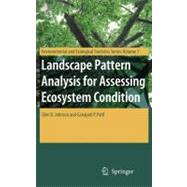
Note: Supplemental materials are not guaranteed with Rental or Used book purchases.
Purchase Benefits
What is included with this book?
| List of Figures | p. ix |
| List of Tables | p. xiii |
| Preface | p. xv |
| Acknowledgments | p. xvii |
| Introduction | p. 1 |
| Loss of Biodiversity through Excessive Habitat Fragmentation | p. 2 |
| Land Use Pattern and Surface Water Quality | p. 5 |
| Quantifying Landscape Pattern | p. 5 |
| Application to Watershed-Delineated Landscapes in Pennsylvania | p. 7 |
| Land Cover Grids | p. 8 |
| Watersheds based on the State Water Management Plan | p. 9 |
| Methods for Quantitative Characterization of Landscape Pattern | p. 13 |
| Single-resolution Measurements | p. 13 |
| The Conditional Entropy Profile | p. 16 |
| Computing Conditional Entropy of Expected Frequencies based on Single -Resolution Maps | p. 18 |
| Illustrations | p. 23 |
| Example 1: Checkerboard Map | p. 23 |
| Example 2: Irregular Black and White Map | p. 26 |
| Example 3: Illustration with Actual Landscapes | p. 36 |
| Classifying Pennsylvania Watersheds on the Basis of Landscape Characteristics | p. 41 |
| Introduction | p. 41 |
| Clustering Watersheds into Common Groups | p. 43 |
| Comparison to Conditional Entropy Profiles | p. 53 |
| Predictability of Surface Water Pollution in Pennsylvania Using Watershed-Based Landscape Measurements | p. 57 |
| Introduction | p. 57 |
| Surface Water Pollution Assessment | p. 57 |
| Nitrogen Loading | p. 57 |
| Pollution Potential Index | p. 60 |
| Selecting an Initial Set of Landscape Pattern Variables | p. 63 |
| Linear Models for Relating Water Pollution Loading to Landscape Variables | p. 66 |
| Predicting In-Stream Nitrogen Loading | p. 68 |
| Predicting a Pollution Potential Index | p. 70 |
| Interpretation | p. 72 |
| Predictability of Bird Community-Based Ecological Integrity Using Landscape Variables | p. 79 |
| Introduction | p. 79 |
| Assessing Ecological Integrity using Songbird Community Composition | p. 80 |
| Background | p. 80 |
| Application to Breeding Bird Data | p. 85 |
| Block-Level BCI Values | p. 85 |
| Watershed-level Ecological Integrity | p. 86 |
| Relating Landscape Attributes to the Songbird-based Assessments of Watershed-wide Ecological Integrity | p. 91 |
| Linear Regression Modeling | p. 91 |
| Clustering | p. 95 |
| Conditional Entropy Profiles | p. 97 |
| Ecological Integrity based on All Species in the Breeding Bird Atlas | p. 100 |
| Relation to Landscape Attributes | p. 101 |
| Comparison of the Different Methods for Computing a Bird Community Index | p. 104 |
| Summary | p. 106 |
| Summary and Future Directions | p. 109 |
| References | p. 115 |
| Index | p. 129 |
| Table of Contents provided by Ingram. All Rights Reserved. |
The New copy of this book will include any supplemental materials advertised. Please check the title of the book to determine if it should include any access cards, study guides, lab manuals, CDs, etc.
The Used, Rental and eBook copies of this book are not guaranteed to include any supplemental materials. Typically, only the book itself is included. This is true even if the title states it includes any access cards, study guides, lab manuals, CDs, etc.